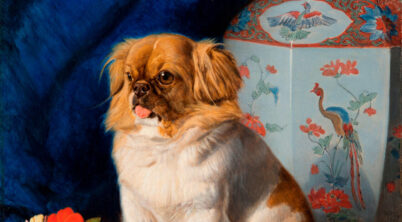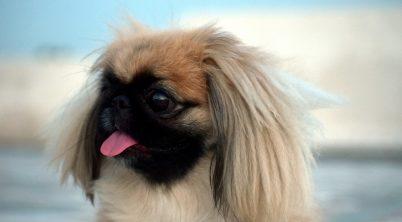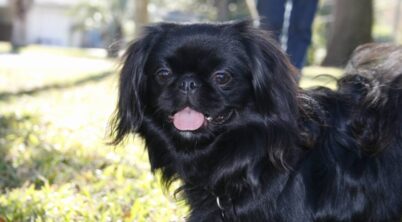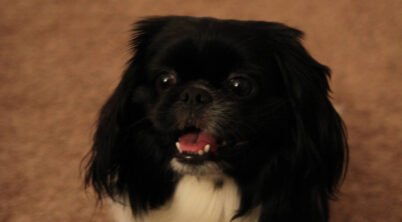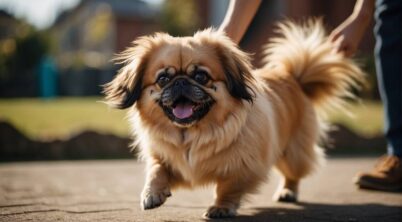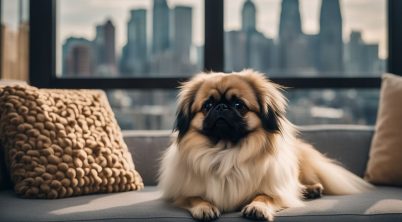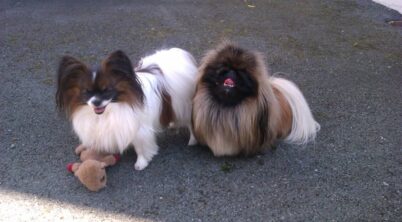The Pekingese, a breed with an illustrious history, traces its roots back to ancient China, where it graced the laps of royalty. Revered in Beijing and beyond, the breed is thought to have been developed to resemble the mighty lion—a symbol of Buddha—earning them the moniker “lion dog.” This breed not only enjoyed the favor of Chinese emperors but also captivated Western royalty; it is said that Queen Victoria owned a Pekingese, marking the beginning of the breed’s popularity in England.
Known for their loyal and regal demeanor, Pekingese dogs carry themselves with a dignified presence that belies their small size. Their long, flowing coat, which requires considerable grooming, contributes to the breed’s lion-like appearance. While they may appear to live for lounging, Pekingese are lively companions, enjoying play and requiring moderate exercise to maintain their health.
Caring for a Pekingese goes beyond regular grooming and exercise; understanding their history and how it shapes their behavior today is crucial for a harmonious relationship. These dogs were once considered sacred in ancient China, which can be reflected in their proud and sometimes aloof behavior. Their storied past is a testament to the breed’s enduring charm, having survived the test of time to remain a beloved companion to many.
Table of Contents
How to Look After Pekingese Dogs
Caring for a Pekingese requires attention to their diet, grooming, exercise, and health monitoring due to their distinct characteristics.
Grooming:
- Regular Brushing: Brush daily using a slicker brush to prevent tangles, paying special attention to their lion-like mane.
- Bathing: Bathe once a month with dog-specific shampoo to maintain a clean coat without stripping natural oils.
- Trimming: Basic trims around the dog’s hindquarters and paw pads help reduce the chance of matting and maintain hygiene.
Feeding:
- Diet: Feed high-quality dog food with the right balance of nutrients tailored for small breeds.
- Schedule: Maintain a consistent feeding schedule and monitor portion sizes to prevent obesity.
Exercise:
- Daily Exercise: Moderate, daily exercise such as walks or play sessions to keep them physically active.
- Overexertion: Avoid strenuous activity, especially in hot weather, due to their susceptibility to heatstroke.
Health Care:
- Regular Vet Check-Ups: Routine vet visits are essential for vaccinations, health screenings, and dental care.
- Watch for Signs: Pekingese can develop respiratory issues and eye problems, so owners should monitor for any signs of distress.
Living Environment:
- Comfort: A comfortable living area with access to water, a cozy bed, and limited stairs, as their short legs can make climbing difficult.
- Temperature Control: Maintain a climate-controlled environment to prevent overheating and stress on their respiratory system.
By following these guidelines, owners can ensure their Pekingese thrives with proper care and affection.
Temperament and Social Traits
The Pekingese is known for its distinctive temperament that combines affection with intelligence and independence. How they fit into family life and their unique behavioral attributes set them apart as bold, albeit small, companions.
Behavioral Qualities
Intelligence: The Pekingese is an intelligent breed, capable of understanding and executing commands, though their independent nature might sometimes be mistaken for stubbornness.
- Confidence: They are self-assured and have a natural confidence that reflects in their demeanor.
- Watchdog Ability: Despite their size, they make good watchdogs—alert and predisposed to bark at the presence of strangers.
- Sociability: Due to their confident personality, Pekingese may not shy away from making their opinions known and may require patient training and socialization.
Interactions with Family
- Loyalty: Pekingese dogs are known to be exceptionally loyal and affectionate to their family members.
- Children: While they can be gentle, their independent streak means that interactions with children should be supervised to ensure that both the dog and children are safe and respected.
- Strangers and Family Dogs: Proper socialization is necessary for them to interact well with strangers and other family dogs. Without it, they can be reserved or irritable around unfamiliar faces.
- Quiet Companionship: Often referred to as “sleeve dogs,” they historically served as companions for royalty and can remain content in a quiet, observant role within the household.
Health and Wellness
Ensuring the health and well-being of a Pekingese involves understanding common health issues and providing a balanced diet. Attentive care can contribute to a life expectancy of 12-14 years for this breed.
Common Health Concerns
The Pekingese breed is notably brachycephalic, meaning they have short noses and flat faces, which can lead to breathing difficulties. Owners should be aware of their Pekingese’s breathing, especially during exercise or hot weather, to prevent respiratory distress. Regular check-ups with a veterinarian are crucial for early detection and management of common health problems, including:
- Breathing issues: Due to their facial structure
- Skin conditions: Manifested as allergies, hair loss, or infections
- Eye concerns: Owing to their prominent eyes
- Weight management: Pekingese are prone to obesity without proper diet and exercise
Owners should be patient and gentle when grooming as the breed’s long coat can easily tangle, particularly behind the ears. It’s important to keep the Pekingese’s coat trimmed to avoid overheating and skin issues.
Diet and Nutrition
The Pekingese requires a well-balanced diet to maintain their health and weight. An adult dog typically needs about 0.75 cups of food per day, equating to roughly 400 calories, split into two meals. Puppies younger than six months should consume about 0.4 cups (225 calories) divided across three meals. Dietary specifics for Pekingese should include:
- High-quality dog food: Suitable for small breeds with adequate nutrition
- Age-appropriate feeding: Adjust portions as they grow and according to their energy levels
- Weight monitoring: To prevent obesity, which can exacerbate health issues
Ensuring a controlled diet and providing opportunities for light, playful exercise will help keep a Pekingese in good shape and support their overall well-being.
Grooming and Maintenance
Grooming is an essential aspect of caring for a Pekingese, a breed often referred to as the “lion dog” for its luxurious mane. They possess a double coat consisting of a thick undercoat and long outercoat which requires regular maintenance to uphold its noble appearance and ensure proper hygiene.
Brushing should be a consistent part of the Pekingese’s grooming regimen to manage shedding and prevent tangles. Ideally, owners should brush their dog several times a week, if not daily, using tools like a slicker brush or a fine-toothed comb. Particular attention should be given to areas behind the ears and under the tail that are more prone to matting.
- Regular Trimming: Although a Pekingese’s coat does not grow continuously like some breeds, they benefit from occasional trimming to maintain a tidy appearance and minimize dirt accumulation.
- Bathing Schedule: Bathing every three to four weeks helps to keep their coat clean. One should use canine-formulated shampoo and warm water, taking care to avoid the eyes.
- Cleaning Essentials:
- Ears: Check and clean them regularly to prevent infections.
- Eyes: Gently wipe away any discharge to prevent irritation.
- Teeth: Brushing teeth or providing dental chews can aid in oral health.
For Pekingese owners, maintaining their pet’s coat is not just about aesthetics; it is a matter of health. Proper grooming supports skin health by removing dead hair and distributing natural oils throughout the coat. Dedication to their grooming needs ensures that the Pekingese remains a happy, hygienic, and well-maintained companion.
Training and Exercise
Training a Pekingese requires patience and consistency, considering their playful nature and stubbornness. Despite this, they possess a notable degree of intelligence, making them capable learners. It’s important to socialize Pekingese puppies early on to develop well-rounded adult dogs. Given the breed’s characteristics, training sessions should be engaging and utilize various toys to maintain the dog’s interest.
Exercise needs for Pekingese dogs are moderate. Puppies can start with short, 10-minute leashed walks, building up to around an hour of physical activity for the adult dog daily. This can be split into two moderate walks, accompanied by a period of play. Care should be taken not to over-exercise these dogs, especially in hot weather, due to their sensitivity to high temperatures.
Table: Weekly Exercise Schedule for Pekingese
| Day | Activity |
|---|---|
| Monday | 15-minute walk + 15 minutes of play |
| Tuesday | 20-minute walk + 10 minutes of play |
| Wednesday | Rest or light play |
| Thursday | 15-minute walk + 15 minutes of play |
| Friday | 20-minute walk + puzzle toys |
| Saturday | Playdate or park visit |
| Sunday | Rest or leisurely walk |
Selecting toys that stimulate the Pekingese’s mind and promote physical activity is beneficial for their overall well-being. When adopting from a breeder or rescue group, ask for any specific training and exercise guidelines they recommend. Always opt for reputable breeders or groups that understand the breed’s needs and can provide valuable insight into their care.
Maintaining a routine that balances training with play is integral to a Pekingese’s health. Short, rewarding training sessions will help in managing their independent streak, while regular exercise keeps them physically and mentally stimulated.

